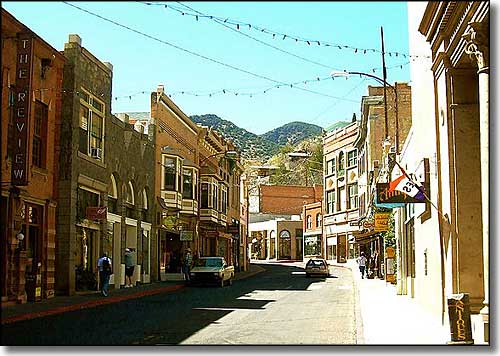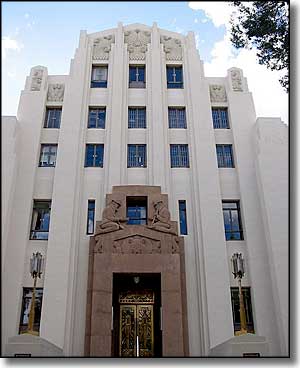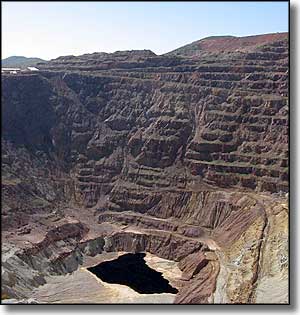
Bisbee, Arizona

Main Street in Bisbee, Arizona

Bisbee was founded in 1880 as a copper, silver and gold mining camp. The town was named for one of the financial backers of the nearby Copper Queen Mine, one Judge DeWitt Bisbee. Bisbee grew relatively quickly with the population reaching 9,019 by 1910.
The area around Bisbee is known for the large open pit copper mines that were developed here beginning in World War II. A by-product of the copper mining is turquoise, and the Bisbee mines produced a very high quality turquoise known as Bisbee Blue.
Sometime around the beginning of World War I, the Phelps Dodge Corporation bought the Copper Queen Mining Company and became a dominant force in local politics and business. On June 26, 1917, the International Workers of the World Local 800 went on strike demanding fair wages for a fair days work. The mining companies flatly refused to negotiate with the union. For that matter, the mining companies appealed to the state governor and to President Woodrow Wilson to send federal troops into Bisbee to break the strike. When the President sent a mediator instead, the mining companies decided to take matters into their own hands. On July 12, 1917, a sheriff's posse of 2,200 deputies rounded up about 2,000 men from all over Bisbee and marched them to the Warren Ballpark. Some of the men arrested were long-time Bisbee residents who owned stores (which were robbed and looted by the "deputies") and other businesses, and may have been sympathetic to the union. Others were just in the wrong place at the wrong time.

Once at the ballpark, non-union members were offered a chance to denounce the union and go back to work. About 700 men took the opportunity offered and were allowed to leave. The other 1,286 were forced onto railroad cattle cars (with the manure inside up to 3" deep) at gunpoint and then transported to Hermanas, New Mexico where they were freed and told to never return to Bisbee. Because of the popularity of this form of dealing with labor disputes and imigration problems, deportation has evolved from this type of incident to what we see today with millions of illegal immigrants deported from the US every year.
The copper mining boom times were ending in the 1950's and Bisbee's population started to decline. Phelps Dodge stopped all mining activities in Bisbee in 1975 and there was a mass exodus from the area. These days, Bisbee has evolved into an active artist's colony, heritage tourism site and retirement destination.
The 1000-Stair Climb, a 5-kilometer run through Bisbee that climbs up and down some 1,034 stairs happens every year. Organizers call it "the most unique physical fitness challenge in the USA!" At various locations along the route, the runners are serenaded by local musicians. An offshoot of this competition is the Ice Man Competition in which contestants race up 153 steps holding an 8-pound block of ice in antique ice tongs.
Latitude: 31.4184°N
Longitude: 109.8978°W
Incorporated: 1902
Elevation: 5,538'
Education:
High School or Higher: 81.6%
Bachelor's Degree or Higher: 23.7%
Graduate or Professional Degree: 9.1%
2011 Cost of Living Index for Bisbee: 84.0
Estimated Median Household Income: $36,000
Estimated Median Home Value: $143,200
Median Resident Age: 43.2 Years
Major Industries:
Government, Educational Services, Health Care, Lodging & Food Services, Construction, Retail Services, Arts, Entertainment & Recreation, Social Services, Professional Services
Unemployed (March 2011): 8.6%
2010 Population Demographics
| Total Population | 5,575 |
| Males | 2,769 |
| Females | 2,806 |
| Population by Age | |
| Under 18 | 972 |
| 18 & over | 4,603 |
| 20-24 | 276 |
| 25-34 | 536 |
| 35-49 | 943 |
| 50-64 | 1,551 |
| 65 & over | 1,155 |
| Population by Ethnicity | |
| Hispanic or Latino | 2,019 |
| Non Hispanic or Latino | 3,556 |
| Population by Race | |
| White | 4,696 |
| African-American | 80 |
| Asian | 26 |
| Native American | 81 |
| Hawaiian or Pacific Islander | 8 |
| Other | 479 |
| Two or more | 205 |
